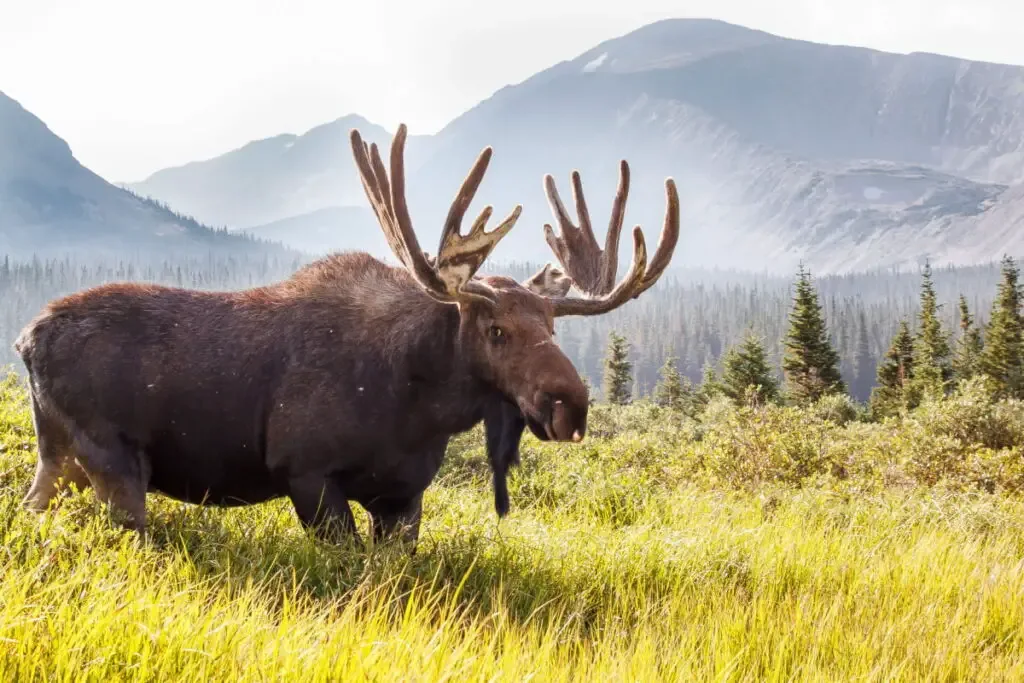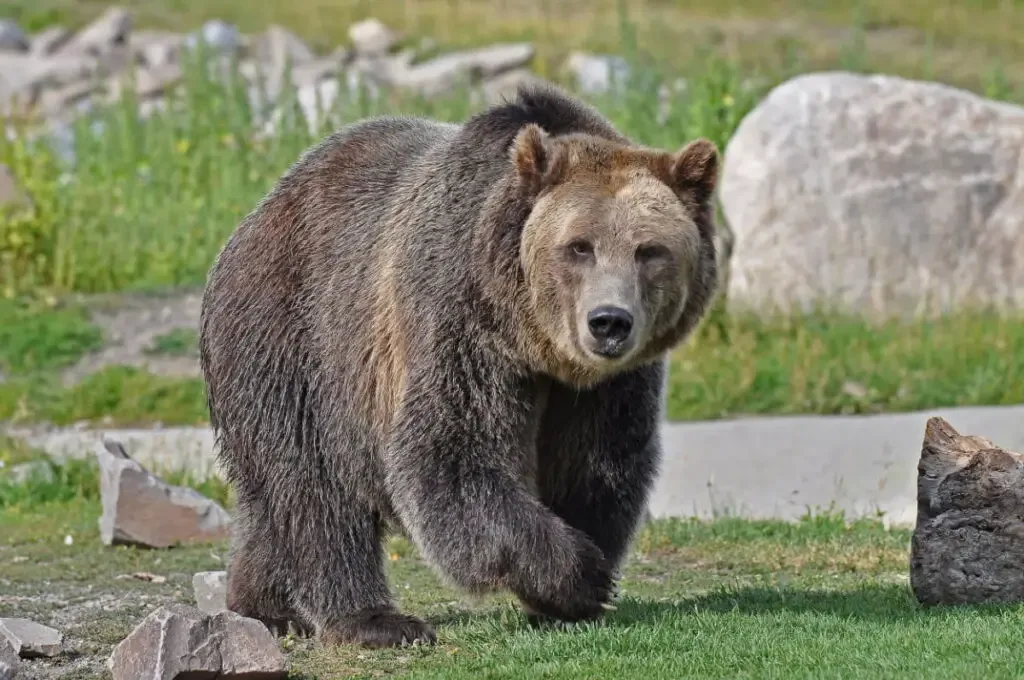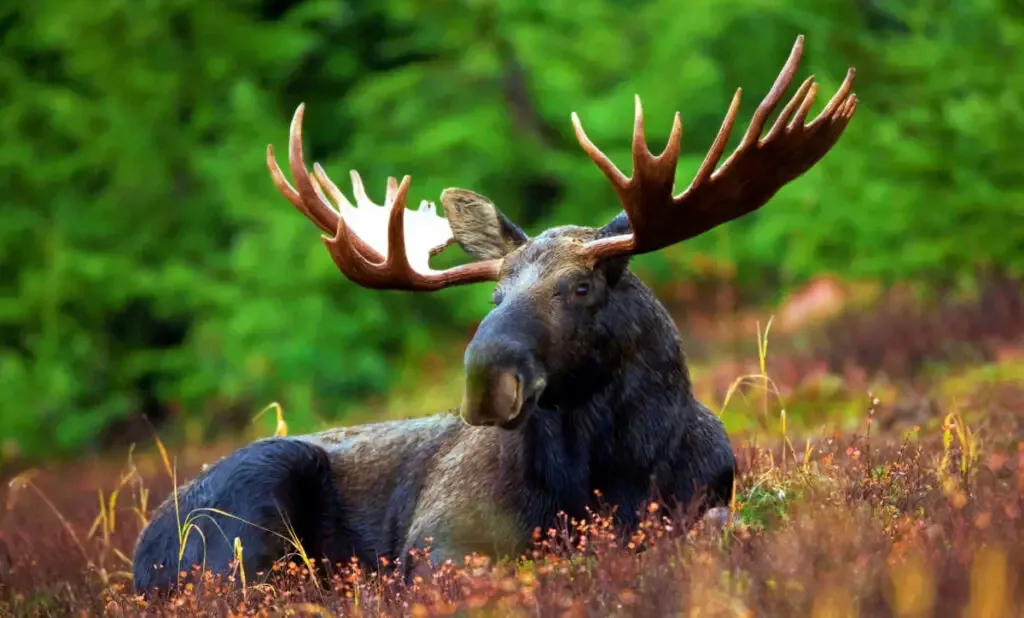Bears are one of the primary predators of moose. So, the question, “bear vs. moose: who wins the fight?” might seem straightforward at first. But then, is the answer truly as simple as it appears? Let us find out.
So, moose vs. bear: who wins the fight?
Generally, bears would win a fight against moose. But depending on size, bear species, and gender, sometimes moose can inflict mortal damage on bears. Still, more times than not, a moose will fall to a bear because bears are more dominant.

If you are wondering how size, bear species, and gender affects a moose’s chances of winning against a bear, we’ve got the details. Below, we talk about how moose will fair in a fight against some species of bears. We also discuss the differences between moose and bears.
Table of Contents
Moose vs. Individual Bear Species: Who Wins the Fight?
Moose vs. Polar Bears
Unsurprisingly, if a moose went up against a polar bear, it would succumb to severe wounds and lose the fight. But if the moose involved were an adult male moose with big antlers, it might have a chance.
To win, the moose would have to strike the polar bear with its antlers quickly, inflicting a deadly wound.
Moose vs. Grizzly Bears
Moose regularly fall prey to grizzly bears. So, you can imagine how a fight between them would go.
Nonetheless, if a small grizzly were to fight a large moose with horns, the moose may just come out triumphant.
Moose vs. Black Bears
A good number of moose calves die at the paws of black bears regularly. This is not surprising since moose calves stand almost no chance against bears. But if a big enough adult moose were to face a black bear, it might fend the bear off.

Differences Between Moose and Bears
Size (Height and Weight)
The sizes of moose and bears are generally comparable. But overall, you could say a moose is larger than a bear.
When fully grown, a moose can be as heavy as 1600 pounds. On the other hand, bears can weigh between 90 to 1300 pounds.
Adult male polar bears weigh around 700 to 1300, while females weigh about 650 pounds.
Adult male black bears weigh around 130 to 660 pounds, while females about 90 to 175 pounds. Fully grown grizzlies weigh up to 800 pounds.
Adult moose can be as tall as 7 to 8 feet when fully grown. When standing upright, grizzlies can be as tall as 8 feet, polar bears stand at around 5.9 to 9.8 feet, and black bears are about 5 to 7 feet.
If you factor in the antlers of male moose, they can stand at up to 9 feet. Also, a moose antler can span up to 6 feet in width. So, overall, moose may appear larger than bears.
Speed
Moose and bears have comparable speeds.
Moose might look lanky, but they can run at a top speed of 35 mph. Black bears and grizzlies can also take short sprints of up to 30 to 35 mph.
Polar bears are not quite as fast as grizzlies and black bears. But they can run as fast as 25 mph for short periods.
Moose and bears can swim, and interestingly, their speed in water is comparable. Moose can reach speeds of up to 6 mph while swimming, and bears can swim at about 6.2 mph.
When it comes to speed, moose and bears are pretty much on par.

Color
Moose coat colors range from black to golden brown, and their fur color varies depending on age and gender.
Newborn moose calves have reddish-brown coats, which fade into a light rust color after a few weeks. Then when summer comes, they lose the light rust fur, taking on the fur color of adult moose.
The face of moose bulls is usually of a darker shade of brown than those of the cows.
Bears can come in various colors, depending on their species. Polar bears have non-pigmented fur. So, they appear white or yellow (before molting). The color of their coats allows them to blend in with the snow and ice in their arctic environment with ease.
Unlike polar bears, grizzly bears can be almost white (very light tan) to dark brown.
Regardless of the color in their name, black bears are not always black. In fact, black bears have more colors than any North American mammal.
Unsurprisingly, most black bears have deep black coats, but they can also be brown, blond, cinnamon, white, or blue-grey.
Strength
The strength of a moose lies in its antlers and hooves. Interestingly, the hooves are actually the first line of defense.
Moose can kick powerfully in virtually all directions with their sharp hooves.
Most times, moose use their antlers for duels and displays with other moose. So, the antlers are rarely used on other animals.
Unlike moose, bears have a wide range of weapons, including claws, jaws, and powerful forelegs.
Talking about jaws, grizzly bears have a bite force of around 975 – 1200 PSI, polar bears have a bite force of 1200 PSI, and black bears can deliver about 980 PSI in one bite.
To put things in perspective, lions have a bite force of 650 PSI, and humans have an average bite force of 162 PSI.
Besides their insanely strong jaws, bears have sturdy shoulders and limb muscles. These features make their swipes very powerful. In fewer words, bears can knock out wolves and mountain lions with one swipe.
Part of a bear’s strength is its claws. Bear claws are pretty thick – thicker than cigars, and they grow as long as 4-6 inches. They may not be sharp, but they tear and scratch when bears need them.
Besides the jaws and powerfully-built limbs, grizzlies can lift over 1000 pounds (around 80% of their weight).
Overall, bears are stronger than moose. They can attack with their paws, claws, and jaws, and they can lift some moose up with ease.

Predatory Instincts
It is pretty obvious which of these animals has the better predatory instincts. It’s a no-brainer; bears prey on moose, so they have the better predatory instincts.
Moose are typically unaggressive – only showing aggression once in a while. The one time to expect violence from moose is their mating season.
When mating season comes, moose – especially male moose – spar and fight a lot.
Unlike moose, bears are not always peaceful. Something as simple as running can trigger their predatory instinct. In other words, if a bear sees a potential prey running, it will chase that prey.

Intelligence
You may think moose are not smart because of their slow movements and unrefined expressions. Contrarily, moose are pretty smart, and they can even solve problems. Also, moose can learn – this is evident in their spar and fighting culture.
You may also think that since moose do not see objects placed directly before them, they are dumb. But this is not true; a moose’s blind spot is the area directly in front of it. Also, moose do not have top-notch vision. These reasons are why they sometimes do not see vehicles coming.
Bears are one of the smartest land animals in North America. In fact, some people claim that bears are smarter than cats and dogs. Still, there are instances of bears doing some not-so-smart things.
The intelligence of bears is evident in their ability to count, solve problems, and use tools. Beyond that, bears can communicate with various animal species.
Diet
We are pretty sure many people think bears are carnivores, but then, things are not quite like that.
Bears may belong to the Carnivora order, but they are actually omnivorous.
Besides eating animal matter, bears can also eat seeds, nuts, fruits, berries, and the like.
Interestingly, the bear digestive system is similar to that of a carnivore. However, it is elongated to allow the efficient digestion of plant matter. So, eating plants poses no problem to bears.
Among grizzly bears, black bears, and polar bears, polar bears have the highest carnivorous tendency. Of course, this is understandable; it is hard to come by plant matter in the arctic ecosystem.
Unlike bears, moose are herbivores. They feed on grasses, twigs, roots, barks, and woody plant shoots. Then when summer comes, they go into the waters to feed on aquatic vegetation, including horsetails, pondweed, and water lilies.
Differences Between Moose and Grizzly Bear, Black Bear, and Polar Bear
| Moose | Grizzly Bear | Black Bear | Polar Bear | |
| Size | Weight – up to 1600 pounds. Height – around 7 to 8 feet at the shoulders. With antlers, they can be up to 9 feet tall. | Weight – up to 800 pounds. Upright Height – up to 8 feet. | Weight – 130 to 660 pounds (male) 90 to 175 pounds (female). Upright Height – 5 to 7 feet. | Weight – 650 to 1300 pounds. Upright Height – 5.9 to 9.8 feet. |
| Speed | 35 mph on land. 6 mph in water. | 30-35 mph on land. Up to 6.2 mph in water. | 30-35 mph on land. Up to 6.2 mph in water. | Around 25 mph on land. Up to 6.2 mph in water. |
| Color | Black to golden brown as adults. Reddish-brown to light rust when young. | Almost white (very light tan) to dark brown. | Black bears have more colors than any North American mammal. They can be deep black, brown, blond, cinnamon, white, or blue-grey. | White after molting. Yellow when covered in oil from the fur of seals. |
| Strength | Their strength lies primarily in their sharp hooves, which they can kick in all directions. They also use their antlers as weapons but to a lesser extent. | Bears have powerful jaws, paws, and claws. Grizzly bears are also heavy lifters. | Bears have powerful jaws, paws, and claws. Grizzly bears are also heavy lifters. | Bears have powerful jaws, paws, and claws. Grizzly bears are also heavy lifters. |
| Predatory Instincts | Moose are generally peaceful. They typically only show aggression during their mating season. | Strong predatory instincts; they may go after a prey just because it is running. | Strong predatory instincts; they may go after a prey just because it is running. | Strong predatory instincts; they may go after a prey just because it is running. |
| Intelligence | They can solve problems and learn. | They can solve problems and learn. | They can communicate with various animal species. They can also use tools, count, and solve problems. | They can communicate with various animal species. They can also use tools, count, and solve problems. |
| Diet | Herbivore | Omnivore | Omnivore | Carnivore |
Final Take
Going by the above, bears have stronger predatory instincts than moose. They also have more weapons than moose, and they are about as fast as moose. So, in a fight, a bear will almost always defeat a moose.
Resources
- https://nedhardy.com/2021/11/03/moose-vs-bear/
- https://faunafacts.com/bears/bear-vs-moose/
- https://www.quora.com/Who-would-win-a-fight-a-grizzly-bear-or-a-moose
- https://www.wideopenspaces.com/how-big-is-a-moose-really/
- https://zooologist.com/how-tall-is-a-grizzly-bear/
- https://zooologist.com/how-tall-is-a-polar-bear/
- http://www.adfg.alaska.gov/index.cfm?adfg=viewing.landmammals&species=moose
- https://bearwise.org/all-about-black-bears
- https://www.treehugger.com/how-fast-can-a-bear-run-5113356#
- https://seaworld.org/animals/all-about/polar-bear/behavior
- https://zooologist.com/how-fast-can-a-polar-bear-swim/
- https://www.adfg.alaska.gov/index.cfm?adfg=moose.main
- https://www.dec.ny.gov/docs/wildlife_pdf/moose1.pdf
- https://bear.org/black-bear-color-phases/
- https://scoutlife.org/video-audio/166569/ouch-10-animals-with-incredibly-strong-bites/
- https://www.totaltails.com/how-strong-is-a-black-bear
- https://www.insider.com/what-to-do-if-you-see-a-bear-attack-2019-4
- https://www.grizzlytimes.org/reading-bear-behavior
- https://seaworld.org/animals/all-about/polar-bear/habitat/
- https://www.sophisticatededge.com/are-moose-smart.html
- https://unofficialnetworks.com/2018/10/18/fun-facts-regarding-the-intelligence-levels-of-bears/
- https://www.organicspamagazine.com/bears-are-smart/
- https://arcticwwf.org/species/polar-bear/diet/
- https://faunafacts.com/bears/carnivores-herbivores-or-omnivores/
- https://nhpbs.org/natureworks/nwep10b.htm
- https://www.nps.gov/yell/learn/nature/bearfoods.htm
- http://naturemappingfoundation.org/natmap/facts/moose_712.html
- https://animals.mom.com/list-endangered-bears-3461.html
